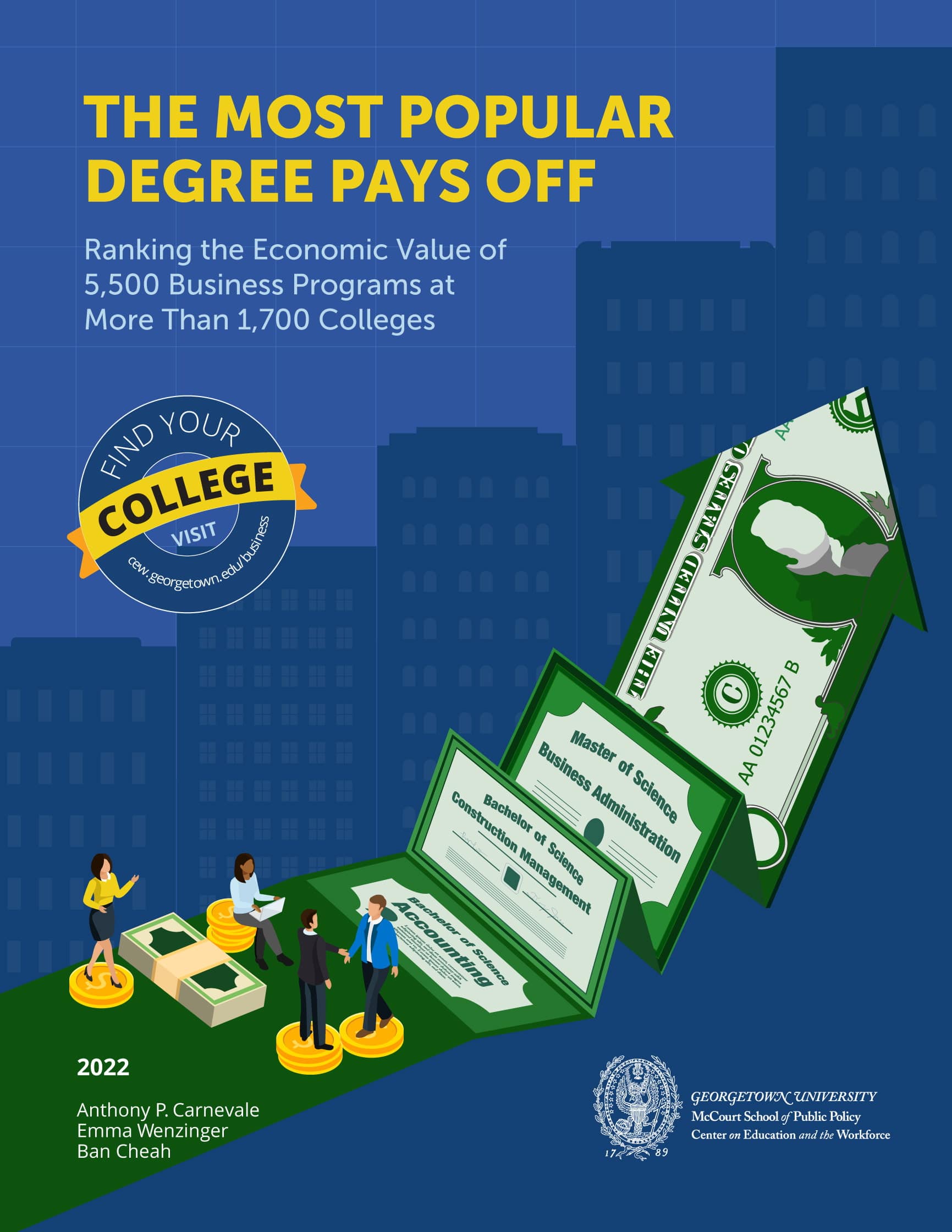The Most Popular Degree Pays Off
Ranking the Economic Value of 5,500 Business Programs at More Than 1,700 Colleges
Summary
Majoring in business typically pays off. While graduates’ earnings and federal student loan debt vary by institution and degree level, the majority of business programs lead to median earnings that are roughly 10 times graduates’ debt payments two years after program completion.
The Most Popular Degree Pays Off: Ranking the Economic Value of 5,500 Business Programs at More Than 1,700 Colleges finds that the economic value of business programs is high compared to the financial returns from other programs, though not as high as returns associated with health, engineering, and computer and information sciences programs. Two years after graduation, associate’s degree holders in business have median annual earnings of $30,000 after debt payments. The financial returns from a business degree rise to $43,200 after debt payments for bachelor’s degree holders and $51,600 for master’s degree holders.
Find Your School
To see how your school stacks up, explore our sortable table of more than 1,700 colleges and universities and 5,500 programs ranked by ROI metrics including earnings, debt payments, and earnings net of debt payments. In the first tab, you’ll find how each institution ranks for business degrees overall. In the second tab, we rank individual programs at many institutions.
Monthly Earnings
Earnings refer to graduates’ median monthly earnings two years after graduation.
Monthly Debt Payments
Monthly debt payments are based on data from the College Scorecard. Note that these data only include federal student loans and do not capture loans from other entities such as institutions, states, or private lenders.
Annual Earnings Net of Debt Payments
This dollar figure represents graduates’ annual earnings net of debt payments two years after they completed a business program. We take debt payments into account in addition to earnings because a significant debt load can offset high earnings.
Degree Level
We compare earnings and debt at the associate’s, bachelor’s, and master’s degree levels.
Source: Georgetown University Center on Education and the Workforce analysis of data from the US Department of Education College Scorecard, 2022.
Note: We weighted median earnings and median debt payments by the number of people in the earnings cohort. We computed annual earnings net of debt payments using rounded values of median monthly earnings net of debt payments.
The data for earnings and debt are up to date as of March 1, 2022. The College Scorecard is frequently updated, often without public notice, so additional data may now be available in the College Scorecard.

Occupations
Earnings vary by business major, but they are also influenced by a worker’s occupation. In the first tab below, we explore earnings for all business majors and find that majoring in business prepares students for a variety of occupations with different earnings potential. For example, early in their careers (ages 22–27), 12 percent of business majors become accountants and auditors, the most common choice for business majors, and have median annual earnings of $57,000.
In the second tab, we further break down the earnings data into 13 business sub-majors to explore what occupations business majors ultimately enter. We find, for example, that 9 percent of those who majored in marketing and marketing research become marketing and sales managers and have median annual earnings of $53,000.
Source: Georgetown University Center on Education and the Workforce analysis of data from the US Census Bureau, American Community Survey micro data, 2009–19, based on full-time, full-year workers ages 22–27 with a bachelor’s degree and no graduate degree.
Note: Occupations with small sample sizes are not included in this figure.
Gender and Race/Ethnicity
Women are gaining representation in business programs, but men with business degrees earn more overall. Women now represent just under half (47 percent) of bachelor’s degree holders who studied business. Among young business bachelor’s degree holders, men earn a median of $50,500 annually, compared to $44,600 for women. At the master’s degree level, women represent 43 percent of degree holders in business and earn $75,600 compared to $99,000 for men at the median.
For those with a bachelor’s degree in business, median early-career earnings are highest for Asian/Asian American workers ($51,300), followed by Multiracial ($48,600), White ($48,600), Hispanic/Latino ($42,600), Black/African American ($40,700), and American Indian/Alaska Native ($39,400) workers. For those with a master’s degree in business, Asian/Asian American workers have the highest median earnings ($100,000), followed by White ($92,000), Hispanic/Latino ($77,700), and Black/African American ($65,000) workers.

Resources
The Most Popular Degree Pays Off: Ranking the Economic Value of 5,500 Business Programs at More Than 1,700 Colleges finds that business degrees typically pay off.

